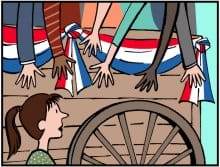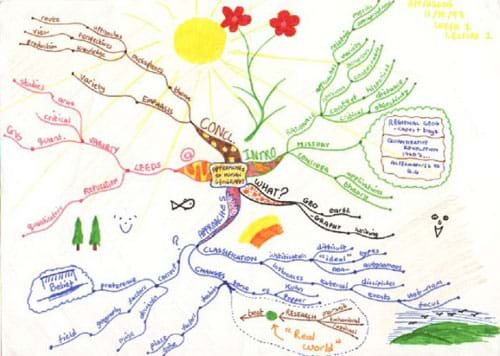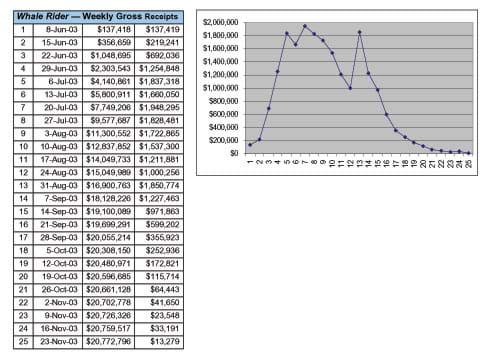Quick Look
Grade Level: 6 (5-7)
Time Required: 1 hours 45 minutes
(two 50-minute sessions)
Expendable Cost/Group: US $0.00
Group Size: 1
Activity Dependency: None
Subject Areas: Physical Science, Physics

Summary
Momentum is not only a physical principle; it is a psychological phenomenon. Students learn how the "Big Mo" of the bandwagon effect contributes to the development of fads and manias, and how modern technology and mass media accelerate and intensify the effect. Students develop media literacy and critical thinking skills to analyze trends and determine the extent to which their decisions may be influenced by those who manipulate a few opinion leaders. Note: The literacy activities for the Mechanics unit are based on physical themes that have broad application to our experience in the world — concepts of rhythm, balance, spin, gravity, levity, inertia, momentum, friction, stress and tension.Engineering Connection
Good engineering ideas can evolve because of the "Big Mo." When some engineers made available the safety option of air bags in select cars, many other manufacturers hopped on the band wagon. Consumers and insurance companies added to the evolution of the idea once they saw crash test results; they generated a buzz about the value and importance of the safety feature for everyone. Now, providing air bags in new cars is a required government safety standard, rather than an "extra."
Learning Objectives
After this activity, students should be able to:
- Students apply skills in analysis, synthesis, evaluation and explanation to their writing and speaking.
- Write and speak in the content areas using the technical vocabulary of the subject accurately. .
- Relate momentum as a physical principle and a psychological phenomenon - something that occurs in everyday life and in engineering design.
Educational Standards
Each TeachEngineering lesson or activity is correlated to one or more K-12 science,
technology, engineering or math (STEM) educational standards.
All 100,000+ K-12 STEM standards covered in TeachEngineering are collected, maintained and packaged by the Achievement Standards Network (ASN),
a project of D2L (www.achievementstandards.org).
In the ASN, standards are hierarchically structured: first by source; e.g., by state; within source by type; e.g., science or mathematics;
within type by subtype, then by grade, etc.
Each TeachEngineering lesson or activity is correlated to one or more K-12 science, technology, engineering or math (STEM) educational standards.
All 100,000+ K-12 STEM standards covered in TeachEngineering are collected, maintained and packaged by the Achievement Standards Network (ASN), a project of D2L (www.achievementstandards.org).
In the ASN, standards are hierarchically structured: first by source; e.g., by state; within source by type; e.g., science or mathematics; within type by subtype, then by grade, etc.
Common Core State Standards - Math
-
Construct and interpret scatter plots for bivariate measurement data to investigate patterns of association between two quantities. Describe patterns such as clustering, outliers, positive or negative association, linear association, and nonlinear association.
(Grade
8)
More Details
Do you agree with this alignment?
-
Distinguish between situations that can be modeled with linear functions and with exponential functions.
(Grades
9 -
12)
More Details
Do you agree with this alignment?
International Technology and Engineering Educators Association - Technology
-
Explain how various relationships can exist between technology and engineering and other content areas.
(Grades
3 -
5)
More Details
Do you agree with this alignment?
Materials List
- paper and pencils
- access to the Internet
Pre-Req Knowledge
Familiarity with the scientific concept of momentum.
Introduction/Motivation
Have you ever bought something just because everyone else was buying it and you just had to have it? That's called "jumping on the bandwagon" and you were helping to create what sociologists, economists, marketers, publicists and political consultants refer to as the bandwagon effect (see Figure 1).

Professional marketers, whether they are promoting the latest pop star or political candidate, try to generate buzz. They want to get people excited and talking about the product they are promoting. This increases the momentum of the bandwagon effect. They want you to jump on board as fast as possible and buy in to the latest fad.
This practice has become so common that it has a name: buzz marketing. Marketing experts look for influential members of the group they seek to target and heavily market their products to these opinion leaders. Sometimes the buzz generated is so contagious, it acts like a virus that jumps from host to host.
A more neutral term for these units of cultural information is meme. Mass media such as television, the Internet and cell phones have greatly increased the speed with which cultural memes, such as the latest buzz, are transferred. Think of the speed with which you can talk to your friends using instant messaging. With a cell phone, you can be directly in touch almost anywhere. It really is not surprising that fads and pop stars are created almost overnight. It is also not surprising that they disappear just as quickly when they become yesterday's buzz.
Did you ever wonder why Hollywood celebrities and millionaire sports heroes get so much free stuff, even though they could afford to pay for it? It is because marketers know they are influential opinion leaders. The fans of these celebrities rush to buy the products their idols are using or wearing because it is "cool."
Several celebrities arrived at the 2004 Academy Awards (Oscars) ceremony driving a Toyota Prius. Chances are they got the car free from Toyota because the publicity and buzz generated by such a statement — "We'd rather drive an environmentally-friendly Prius than a gas-guzzling limousine" — is worth gold. Celebrities who presented the Oscars received a bag of gifts, called swag, valued at over $100,000, all because the companies marketing the products wanted to be associated with the event.
Would you buy a car because an Oscar winner rode in it? Would you buy a watch because Tiger Woods endorsed it? Would you wear a tank top because it had Mary Kate and Ashley's name on it? Would you buy something you don't really want or need just because it was cool? Or, would you be more likely to make up your own mind and let the bandwagon pass you by?
Procedure
"Children and teens are particularly susceptible to bandwagon fallacies because their range of experiences with media messages and real life interactions are limited. The bandwagon effect is particularly successful with those who have a lack of self-esteem and want to be like others. ...Without solid media literacy skills to dismantle bandwagon messaging techniques, adolescents remain especially susceptible to feeling like the odd one out if they do not purchase the latest item or see the hottest movie or buy the latest fashion."
Source: The Trouble with Harry: A Reason for Teaching Media Literacy to Young Adults by Diane Penrod, Rowan University, found at The Writing Instructor, Purdue University, IN, http://www.writinginstructor.com/penrod.html
The focus of this activity is to help students develop media literacy and critical thinking skills. As they learn more about the bandwagon effect and consider the psychological effects of cultural momentum, they become more aware of the powerful influence of opinion leaders.
Observing
Use the resources in the References section to assign students background reading and research to learn more about the bandwagon effect and the bandwagon fallacy.
A mind map shows interrelationships of concepts and is a creative way of capturing one's thoughts on a topic (see Figure 2). Make an illustrated mind map of the bandwagon effect and related concepts such as fads, manias, trends, propaganda, buzz, buzz marketing, word-of-mouth advertising, consumer, influencer, opinion leader, peer-pressure, persuasion, influence, momentum, geometric progression, etc., in order to better understand how the phenomenon of the bandwagon effect works.

The momentum of the bandwagon effect typically develops by geometric progression. Observe the difference in the curve of an arithmetic progression and a geometric progression (see Figure 3). An arithmetic progression increases by addition. A geometric progression increases by multiplication.

Looking at the example graphs, the values on the arithmetic progression graph increase by the rule "add two" (1, 3, 5, 7, 9, 11... etc.). The values for the geometric progression increase by the rule "multiply by two" (1, 2, 4, 8, 16, 32, 64... etc.). Notice that the values for the geometric progression increase much more rapidly over the same period of time than the values for the arithmetic progression. Sometimes the graph of a geometric progression is called a "hockey stick" because it slopes upward so rapidly.
Thinking
Below is a list of recent examples of the bandwagon effect in popular culture. In each case, momentum developed very rapidly, following a geometric progression. In some cases the fad developed almost overnight to the point of mania, with millions of fans instantly jumping on board. Discuss the upside and the downside of the phenomenon in each case:
- Harry Potter (book series)
- American Idol, Survivor and other "Reality TV" shows
- The latest "must-have" toy (Tickle Me Elmo, Bionicles, Cabbage Patch Kids [ask your parents about this craze])
- Pokemon or Yu-Gi-Oh collection cards
- Nintendo/PlayStation video games
- Britney Spears and other pop music idols
- Blockbuster (mega hit) films such as Lord of the Rings and Pirates of the Caribbean
Fads and manias are nothing new. During the 17th century Dutch "Tulip Mania," a single prized bulb could cost 10 times a person's average annual salary! But, this phenomenon took more than 75 years to reach its height. Discuss how the following media tools can work to create a bandwagon effect almost overnight:
- Television
- Internet
- Radio
- Instant messaging
- Magazines
- Cell phones
- Chain letters
- Opinion polls
Writing
- Write about a time when you jumped on a bandwagon. Was it a positive or negative experience? Maybe you waited in a long line to see a big movie on its opening day; or you pleaded with your parents to order a popular book even before it was published; or you begged for the latest, hottest toy or video game or trading card. Were you happy with it (the film, book, toy, etc.)? Were you disappointed?
How did you first hear about the new fad? On TV? Through the Internet? Who or what influenced you to hop on board the bandwagon? Did one person especially influence you? Did you feel pressured or did you feel as though you were thinking for yourself? Did you in turn influence someone else to buy in? If you were successful influencing someone else, how did that make you feel? Did you ever feel you wanted something so much that you couldn't think clearly, that it felt almost painful not to have it? Describe in as much detail as you can how you felt and why.
- Heroes are those who are able to stand up to powerful social forces such as the bandwagon effect, or who act as opinion leaders to get the wagon rolling in the right direction. In the book, The Light of Conscience: How a Simple Act Can Change Your Life, author Bill Shore describes the impact of baseball player Pee Wee Reese's gesture of friendship to Jackie Robinson, the man who broke baseball's color line. You can read more about this story in the Jackie Robinson section (2.2) of https://en.wikipedia.org/wiki/Pee_Wee_Reese.
Write about a time when you were able to resist the power of the bandwagon effect and were proud or glad that you did. Or, write about a time when you were able to start a bandwagon rolling for a good cause or helped someone else to do so.
Vocabulary/Definitions
bandwagon effect: The phenomenon of a popular trend attracting even greater popularity: "polls are accused of creating a bandwagon effect to benefit their candidate" (Source: WordNet, a lexical database for the English language, Princeton University, NJ, www.cogsci.princeton.edu/cgi-bin/webwn)
big mo : (slang) Momentum.
buzz : (slang) 1) Excited interest or attention. 2) Rumor; gossip: the latest buzz from Hollywood. A slang term for word-of-mouth advertising.
chain letter: A letter sent to a number of people asking each recipient to send copies with the same request to a specified number of others. Circulation increases in geometrical progression as long as the instructions are followed by all recipients.
consumer: One who purchases goods and services.
fad: A fashion that is taken up with great enthusiasm for a brief period of time; a craze.
geometric progression: A sequence, such as the numbers 1, 3, 9, 27, 81, in which each term is multiplied by a constant term (in this case 3) in order to obtain the following term. A geometric progression rapidly increases as compared with an arithmetic progression, a sequence, such as the numbers 1, 3, 5, 7, 9..., in which each term after the first is formed by adding a constant (in this case 2) to the preceding term.
influence: 1) A power affecting a person, thing or course of events, especially one that operates without any direct or apparent effort: relaxed under the influence of the music; the influence of television on modern life. 2) Power to sway or affect based on prestige, wealth, ability or position: used her parent's influence to get the job.
mania: An excessively intense enthusiasm or interest; a craze: a mania for neatness.
meme: A unit of cultural information, such as a cultural practice or idea, that is transmitted verbally or by repeated action from one mind to another.
momentum: 1) The force or energy of a physical object in motion. 2) The force or energy of a nonphysical process, such as an idea or a course of events: The soaring rise in interest rates finally appeared to be losing momentum.
opinion leader: Person whose opinion molds public opinion; in a group, an individual whose ideas influence the direction or decision of a group.
persuasion: The ability to influence someone to take a course of action or embrace a point of view by means of argument, reasoning or emotional appeal: "to make children fit to live in a society by persuading them to learn and accept its codes" (Source: Alan W. Watts)
phenomenon: (pl. phenomena) 1) An occurrence, circumstance, or fact that is perceptible by the senses. 2) An unusual, significant, or unaccountable fact or occurrence. 3) A marvel; a remarkable or outstanding person; a paragon.
swag : (slang) 1) Valuable goods. 2) A thief's booty. 3) Free gifts or "loot" presented to celebrities in exchange for their services by marketers seeking to promote products by association with the celebrities.
trend: 1) The general direction in which something tends to move. 2) A general tendency or inclination. 3) Current style; vogue: the latest trend in fashion.
Assessment
Pre-Activity Assessment
Vocabulary Quiz: Reinforce the basic concepts and vocabulary introduced during the Observing activity with a quiz.
Activity Embedded Assessment
Call-Out Questions: Use call-out questions during the Thinking discussion to test students' understanding of the concepts.
Post-Activity Assessment
Expressive Writing: Evaluate the students' written accounts of their experiences with the bandwagon effect in terms of how well they develop true plot lines for their own experiences and demonstrate understanding of their significance.
Discussion Questions: Ask the students, and discuss as a class:
- How is the idea of momentum in the bandwagon effect similar and dissimilar to the physical force of momentum? (Answer: Momentum has two definitions. They both describe a force or energy, but one definition is in terms of a physical object in motion, and the other is in terms of a nonphysical process, such as an idea or course of events.)
- If an engineer was designing a rollercoaster or train track, which definition of momentum would apply to his work? (Answer: The scientific one. A force or energy of a physical object in motion.)
- Provide examples using each definition of momentum. (Possible answers: The sled came to a stop at the bottom of the hill, finally losing momentum. The momentum to recycle was growing in every neighborhood in town.)
Safety Issues
- Both directly and indirectly, this activity aims to improve students' physical safety and psychological well-being by helping them evaluate media claims and develop their own inner resources to resist peer pressure when necessary.
Troubleshooting Tips
Although young people are susceptible to peer influence, some have become media-savvy. The advice to marketers provided by Reveries.com (See "Verbatims" in the References section) is good to keep in mind in presenting this activity. Students can be quite skeptical about media claims and resist the efforts of marketers to get them to part with their allowances. The challenge is to transfer this healthy skepticism and independent spirit to their interactions with their immediate peer group, whose influence is likely to be more potent and personal.
Plan on 50 minutes to introduce concepts and 50 minutes for discussion.
Activity Extensions
- The average Hollywood blockbuster is so heavily marketed it typically opens with a bang and big box office receipts — especially if it has generated good critical buzz. This is usually reflected in huge first weekend gross earnings that gradually taper off over the following weeks. In other words, the movie-going public is already on the bandwagon even before the film opens!
More interesting is the power of the bandwagon effect to create the so-called "sleeper hit," a film that succeeds far beyond advance expectations and without the artificial hype of a multi-million dollar promotional campaign. Word-of-mouth advertising takes over as people who like the film recommend it to their friends, who in turn tell their friends, and so on. The film now "has legs" (momentum) and becomes a hit.
Chart the success of the 2003 New Zealand film, Whale Rider. It was made for approximately $3.9 million and grossed (earned) close to $21 million in revenue in the U.S. alone. Figure 4 shows a graph of the weekly ticket receipts for the 25-week run of the film in the U.S., starting with opening weekend receipts of $137,418 and rising quickly to $1,948,295 in week seven. Note the "hockey stick" of the geometric progression as the film rapidly gains in popularity in its first five weeks, doubling and then tripling its receipts because of the good word-of-mouth advertising (buzz) that it generated. (Source: Internet Movie Database, http://www.imdb.com/title/tt0298228/business)

An even more remarkable sleeper hit was the 2002 U.S. film, My Big Fat Greek Wedding. Made for a mere $5 million, it opened with receipts of $597,362 and went on to earn over $350 million worldwide. Chart the progress of the U.S. run of the film as it gains momentum, approximately doubling its receipts each week for the first four weeks after opening and then continuing its steady climb. Use data from the Internet Movie Database, http://www.imdb.com/title/tt0259446/business.
Give students the data in the chart and have them graph it. Then have the students discuss the shape of the graph and the different trends they see.
- Whale Rider is a powerfully moving film, well deserving its success. See the film and then answer the following questions (caution: spoilers!):
- In what sense is Paikea a hero? (Answer: Her actions serve to unite her tribe and restore their spirit.)
- Does she know her own mind? (Answer: Yes, she has a strong sense of her destiny and is able to stand up to her grandfather while maintaining her respect for him.)
- In what ways does she resist the traditions of her tribe and stand up to her grandfather? (Answer: She learns the ways of a chief.)
- How and when does Paikea create a bandwagon effect? (Answer: When she rides the whale in the climactic scene of the film.)
- How does she fulfill her destiny? (Answer: She is accepted as a "great chief" by her grandfather and leads the warrior's chant with her grandfather's blessing.)
- The bandwagon effect is related to the bandwagon fallacy, the claim that something is proven or valid just because a lot of people do it. Discuss examples of the bandwagon fallacy. (See Wikipedia, The Free Encyclopedia, http://en.wikipedia.org/wiki/Bandwagon_fallacy )
- Go on a meme hunt — a cultural scavenger hunt. How many ideas can you think of that were so "contagious" they spread like a flu virus? Make a list of concepts — good and not-so-good — that jumped from mind to mind, changing the way people think and behave.
- Political candidates hope to develop enough momentum — the Big Mo — to carry them straight through the election campaign and into office. In advance of the 2004 presidential election, aspiring democratic candidate Howard Dean gained momentum early on and then lost it almost overnight. How and why did that happen? Find out and report back to the class.
Activity Scaling
- The mind-mapping of the bandwagon effect (Observing section) and discussion (Thinking section) are group activities. Concepts can be kept simple or developed to a greater level of complexity, depending on the abilities of the students. Because the writing activity is based on personal experience, it can be similarly scaled.
Subscribe
Get the inside scoop on all things TeachEngineering such as new site features, curriculum updates, video releases, and more by signing up for our newsletter!More Curriculum Like This

Students also investigate the psychological phenomenon of momentum; they see how the "big mo" of the bandwagon effect contributes to the development of fads and manias, and how modern technology and mass media accelerate and intensify the effect.
References
Bandwagon: Common Techniques > Special Appeals. Updated September 29, 2002. Propaganda Critic. www.propagandacritic.com/articles/ct.sa.bandwagon.html Accessed May 12, 2004.
Bandwagon Effect. Wikipedia, The Free Encyclopedia. www.wikipedia.org Accessed May 12, 2004.
Bandwagon Fallacy. Wikipedia, The Free Encyclopedia. www.wikipedia.org Accessed May 12, 2004.
Barker, Olivia. Awards Show Gifts Graded. USA TODAY.com. www.usatoday.com/life/movies/movieawards/oscars/2004-02-24-award-show-gift-baskets_x.htm Accessed May 12, 2004.
Center for Media Literacy. GPN Educational Media. www.medialit.org Accessed May 12, 2004.
Cialdini, Robert. Influence: The Psychology of Persuasion. Quill, 1998.
Dictionary.com. Lexico Publishing Group, LLC. Accessed May 5, 2004. (Source of vocabulary definitions, with some adaptation)
Edelman, Ric. Tulip Bulbs and the Stock Market. Edelman Financial Services, Inc. (The story of tulip mania) www.ricedelman.com Accessed May 12, 2004.
The History of Cultural Selection Theory, Section 2.8, "Memetics." Agner Fog. www.agner.org/cultsel/chapt2 Accessed May 12, 2004.
Mackay, Charles. Memoirs of Extraordinary Popular Delusions and the Madness of Crowds. The Library of Economics and Liberty. London, England: Richard Bentley, New Burlington Street, Publisher in Ordinary to Her Majesty, 1852. http://www.econlib.org/library/Mackay/macEx.html Accessed May 12, 2004. (Complete text online)
Math Basics, 461-3, Arithmetic vs. Geometric Progressions. Center for Digital Arts and Experimental Media, University of Washington. www.dxarts.washington.edu Accessed May 12, 2004.
Media Literacy Online Project. College of Education, University of Oregon, Eugene, OR. http://interact.uoregon.edu/medialit/MLR/home/ Accessed September 12, 2006.
Shore, Bill. The Light of Conscience: How a Simple Act Can Change Your Life. New York, NY: Random House, 2004.
Verbatims: What is the most critical misunderstanding that marketers have about marketing to kids? Reveries Magazine. www.reveries.com/reverb/research/kids/mistakes.html Accessed May 12, 2004. (A list of verbatim comments based on surveys of what works in marketing to kids)
Copyright
© 2004 by Regents of the University of Colorado.Contributors
Jane Evenson; Malinda Schaefer Zarske; Denise W. CarlsonSupporting Program
Integrated Teaching and Learning Program, College of Engineering, University of Colorado BoulderAcknowledgements
The contents of this digital library curriculum were developed under a grant from the Fund for the Improvement of Postsecondary Education (FIPSE), U.S. Department of Education, and National Science Foundation GK-12 grant no 0338326. However, these contents do not necessarily represent the policies of the Department of Education or National Science Foundation, and you should not assume endorsement by the federal government.
Last modified: July 29, 2020






User Comments & Tips